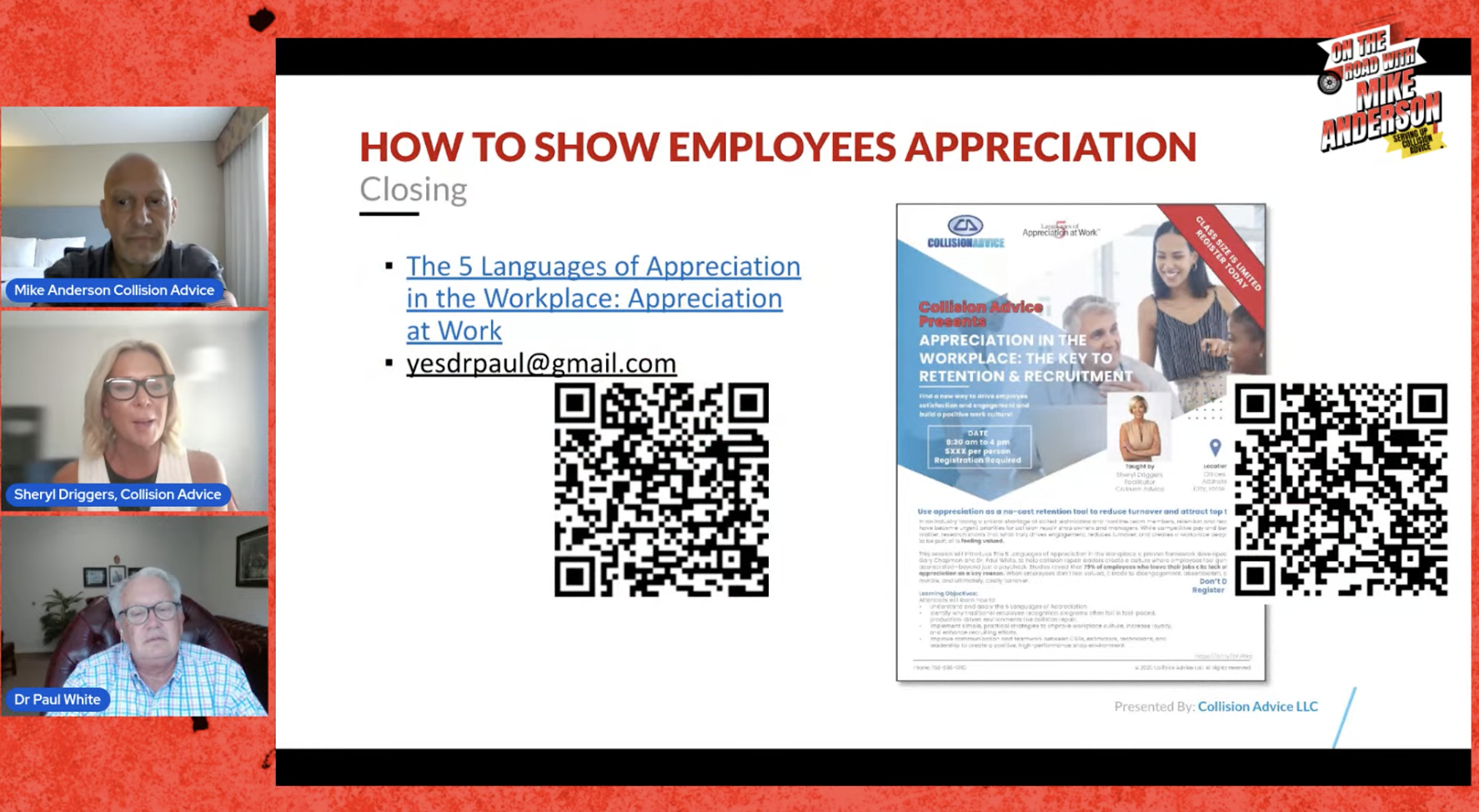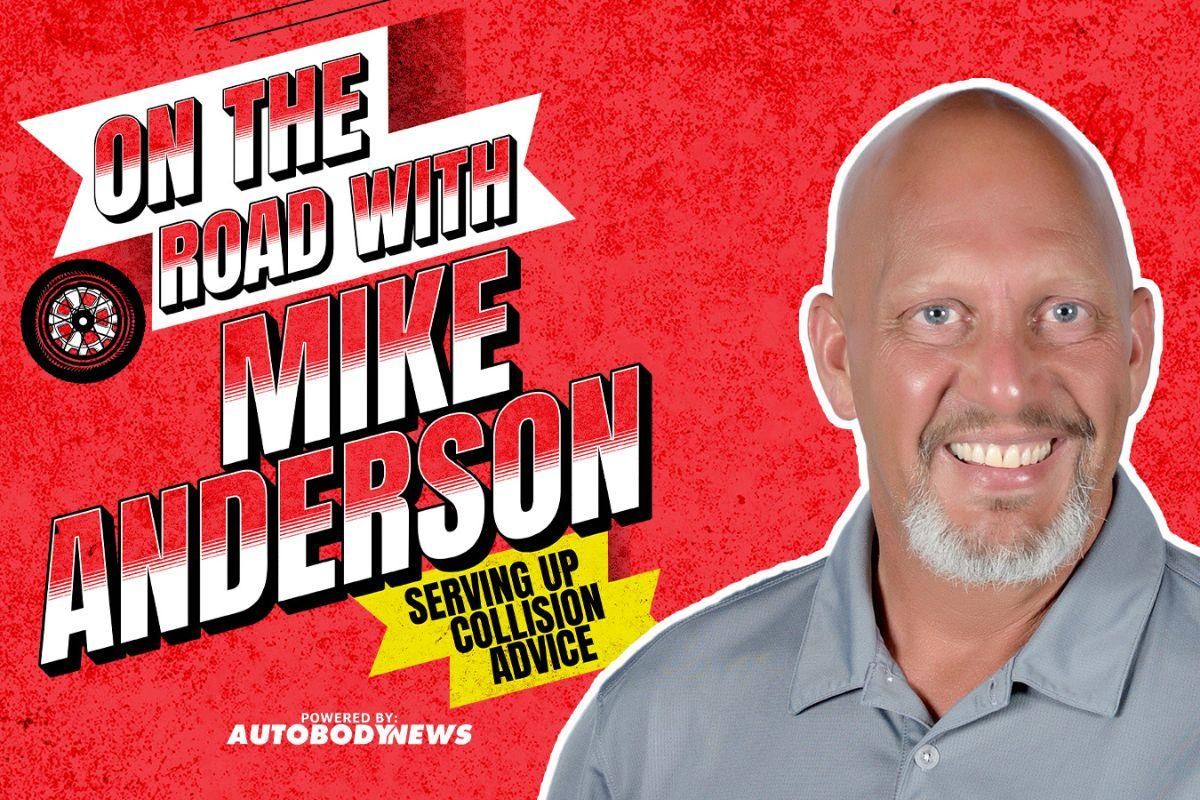'On the Road with Mike Anderson' Live Podcast Explores Appreciation That Impacts Performance
Showing appreciation in the ways that mean most to employees can boost retention, production and profitability.
The latest episode of “On the Road with Mike Anderson — Serving Up Collision Advice,” a new live podcast powered by Autobody News, featured a discussion with Dr. to talk about how collision repair shops can benefit from learning and implementing the best ways to show their employees they are appreciated.
White is the co-author of “The Five Languages of Appreciation in the Workplace,” along with , a book that has been translated into 25 languages and sold more than 600,000 copies worldwide. Its resources are used by Mercedes-Benz, Daimler Trucks, Ford and General Motors.
White spoke with and Sheryl Driggers of Collision Advice about how effectively showing authentic appreciation improves workplace culture and, along with it, employee retention, production and profitability.
After airing live July 14, the episode is available for viewing on demand on Autobody News’ YouTube channel.
Research shows when team members feel valued, they show up on time, stay with the company longer, have less conflict and fewer accidents, follow procedures and earn better customer service ratings.
This stands out to investors, White said, because they “want to invest in companies that take care of their people, because they make more money.”
Driggers said a survey of 840 collision repair technicians, conducted by Ducker Carlisle and the Society of Collision Repair Specialists (SCRS), found the top reason they would leave their current job is a negative workplace culture that makes them feel like they are not valued.
“We are excited to have Dr. White with us here today because we need to learn how to show authentic appreciation in the form the team member wants,” Driggers said.
Anderson said he has touted the book and its advice for several years in presentations and his work with performance groups, after applying it to his own business when he was still a shop owner.
White said showing employee appreciation hasn’t been modeled in U.S. culture, particularly in hands-on industries like collision repair. When he and Chapman first wrote the book in 2011, they weren’t targeting trades like auto repair and construction, but it has caught on amongst them in the 14 years since.
Many people “think [showing appreciation] just means you say ‘thanks,’ but it’s just words,” White said.
He said there is a difference between recognition and appreciation.
Recognition is largely institutional and “comes down from the top,” like an employee of the month program, and is mainly focused on performance — what the employee is doing for the company.
“What we see in real life is [recognition] doesn’t have a lot of impact,” White said. More than 90% of companies have some sort of recognition program, but employee satisfaction is still low and turnover high.
“Employees are people,” White said. “We like to be acknowledged for who we are besides just what we do.”
Driggers agreed. She said she met with technicians individually when working on a presentation.
“One said, ‘I want to be appreciated for who I am, not what I can do for the organization,’” she said.
White discussed the five languages of appreciation in the workplace, in order of most to least preferred, according to people who have completed an assessment.
“Words of affirmation” speak to the value or worth of someone else. About 44% of assessment takers preferred that language.
“It starts with ‘thanks;’ that’s the simplest one,” White said.
However, people report they don’t like to just hear “good job,” because it’s vague and low-effort.
Instead, use the person’s name and be specific about what they did and why it is important to you and the business.
In a body shop, that could look like acknowledging an employee who effectively responded to an upset customer.
It’s also important to recognize how the employee would want to hear those words of affirmation, White pointed out. Some might like a one-on-one discussion, but others might prefer an email, voicemail or note to avoid having to speak face to face.
“It can be done wrong — about 40% of people don’t want to be praised in front of large groups, because they find it embarrassing,” he added.
Anderson said often, a body technician will only get feedback on post-repair inspections if something was wrong. White said praising the overall quality of a repair first could “soften the blow” when pointing out something that was missed or not done correctly.
The second most popular language was quality time, preferred by 26% of assessment takers.
White said quality time is “an interesting one,” as the desired delivery is different across generations. Baby Boomers largely prefer time with their supervisors to share observations or get input, while younger generations would rather spend time with their peers.
Either way, the people who prefer quality time say it makes them feel valued and included, White said.
Driggers said when she owned shops, her employees would go to lunch together, or the shop would provide lunch during working hours. They also enjoyed activities outside of working hours, like axe throwing, go-kart racing or bowling. Facilitating those activities also improved the work environment.
“The cool thing about quality time is it helps you learn more about coworkers or employees in different ways,” White said.
About 21% of assessment takers preferred acts of service.
White said that doesn’t mean “bailing out” low-performing coworkers, but rather noticing when they are stressed out by a deadline or a line of customers at the front desk and stepping in to help.
“Don’t tell me you support me, show me,” he said.
The key is to not ask “Do you need help?” Most often, people will say they don’t need it. Instead, ask “What can I do to help?”
Then, do the task the way they would do it. “This is not the time to teach them a new way,” White said.
“If you can help someone out when they’re stressed and dealing with a lot of demands, it can have a lot of impact,” he said.
Driggers offered the example of helping someone get caught up on updating customers about their repairs.
Anderson said when he was a shop owner, he would help the car washer if it was the end of the week and there were a lot of vehicles that needed to be washed before delivery.
Now, as the owner of Collision Advice, Anderson said he heard from a shop owner client that his best body technician was leaving for more money. Anderson said he knew the tech too and reached out to find out the real reason — the shop he was leaving for was willing to send him to be trained as Mercedes-Benz-certified tech, and he liked the prestige.
“A lot people in this industry will say ‘I’m not into all that touchy feely stuff,’ but this is applicable,” Anderson said. “If you really understand how to make someone feel appreciated, they will run through walls for you.”
Driggers added shop managers shouldn’t only show appreciation to get a result though; the result is a byproduct.
“I tell people, don’t try to fake it because people can see through it, and that undermines any trust,” White agreed.
About 9% of assessment takers like to received tangible gifts, White said. That doesn’t mean bonuses or raises, but “small stuff that shows you’re getting to know your colleagues and what they like.”
That could be their favorite coffee or tickets to a local sports event, or even something that doesn’t cost anything, like sharing a website with information about something they care about outside of work.
“It’s about getting to know them as a person,” White said.
Tangible gifts can be good if they are matched with other interests — do not just give employees gear with the company logo, for instance.
“Our industry is famous for pizza parties,” Anderson said. “The five languages of appreciation is more than just buying your people pizza from Domino’s.”
The least popular language in the U.S. is physical touch. Less than 1% of assessment takers prefer it, White said.
“People in the U.S. are weird about this one; they think they’ll get sued,” he said.
Other cultures regularly greet each other with a hug or kiss on the cheek, but in the U.S., physical touch as an appreciation language means a high five, fist bump or handshake, usually something “spontaneous to celebrate,” White said.
Just asking someone to name their preferred language is “a weird question in our culture and you won’t get much,” White said.
 White shared resources to get in touch with him and his team.
White shared resources to get in touch with him and his team.
He and his team created the assessment, available in the book or on their website, to help identify people’s languages.
The results can be used to create profiles to help managers and supervisors learn how to show the appreciation that’s most meaningful to team members.
White’s team also offers training, a facilitator’s guide and professional consultants.
He said anyone can email him at [email protected] with “collision advice” in the subject line, and he will send back a sample report and group profile, as well as an article the New York Times wrote about a mining company in South Dakota that implemented the appreciation languages.
The next episode of “On the Road with Mike Anderson — Serving Up Collision Advice” will be broadcast live at 4 p.m. ET/1 p.m. PT Aug. 11 and available on demand after.
Anderson will give an overview of the state of the industry, looking at trends in claims counts, customer pays, OEM certifications and more.
You may also like...
Diddy's Legal Troubles & Racketeering Trial

Music mogul Sean 'Diddy' Combs was acquitted of sex trafficking and racketeering charges but convicted on transportation...
Thomas Partey Faces Rape & Sexual Assault Charges

Former Arsenal midfielder Thomas Partey has been formally charged with multiple counts of rape and sexual assault by UK ...
Nigeria Universities Changes Admission Policies

JAMB has clarified its admission policies, rectifying a student's status, reiterating the necessity of its Central Admis...
Ghana's Economic Reforms & Gold Sector Initiatives

Ghana is undertaking a comprehensive economic overhaul with President John Dramani Mahama's 24-Hour Economy and Accelera...
WAFCON 2024 African Women's Football Tournament

The 2024 Women's Africa Cup of Nations opened with thrilling matches, seeing Nigeria's Super Falcons secure a dominant 3...
Emergence & Dynamics of Nigeria's ADC Coalition

A new opposition coalition, led by the African Democratic Congress (ADC), is emerging to challenge President Bola Ahmed ...
Demise of Olubadan of Ibadanland
Oba Owolabi Olakulehin, the 43rd Olubadan of Ibadanland, has died at 90, concluding a life of distinguished service in t...
Death of Nigerian Goalkeeping Legend Peter Rufai

Nigerian football mourns the death of legendary Super Eagles goalkeeper Peter Rufai, who passed away at 61. Known as 'Do...




